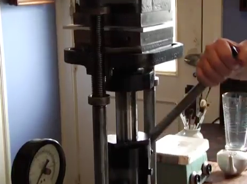WOODBURYTYPE
“The Woodburytype is not made by light, it is not made by chemicals, it’s molded, it’s made in a mold.” --Mark Osterman (GeorgeEastmanHouse, 2012)
 The Inventor:
The Inventor:
The Woodburytype was invented in 1864 by Englishman Walter Bentley Woodbury.
Growing up, Woodbury would use old cigar boxes and lenses from glasses to make his own camera obscura. This early passion increased as Woodbury’s teenage years coincided with the introduction of wet-plate collodion process. Using this process, Woodbury became a professional photographer, first by capturing buildings in Australia, then by taking stereoscopic views on the Indonesian Island of Java.
His inspiration for the Woodburytype occurred while experimenting with the carbon printing process. By late 1864, he secured his idea by making permanent copies of photographs using relief printing (Jay, 1988).
W.B. Woodbury. 1888. Published in "A History of
Photography: Written as a Practical Guide and
an Introduction to its Latest Developments"
by W. Jerome Harrison (Bradford: Percy Lund & Co.,
The Country Press - London: Trubner & Co, 1888).
Other Players:
In 1839 Mungo Ponton discovered that potassium bichromate, when spread on paper, is sensitive to light. The parts of the paper that had been exposed to light would harden, leaving the unexposed parts soft. These soft parts could be washed away, leaving a permanent image (Jay, 1988).
William Henry Fox Talbot expanded on Ponton’s discovery when he determined that gelatin would also react the same way when mixed with potassium bichromate (Jay, 1988).
Helpful Definitions:
Photomechanical Process: “Processes that involve a photographic process (that is, employing light-sensitivity) to transfer an image, and then a separate process to produce a print that was never itself light-sensitive” (Art & Architecture,ID: 300053509, 2004).
Potassium Bichromate: “A photographic emulsion used in nineteenth century printing processes.” (Material Name, 2004).
Bichromated Gelatin: When potassium bichromate is added to gelatin it would harden when exposed to light. By exposing the bichromated gelatin under a negative, the gelatin would “harden in proportion to the amount of light the negative had allowed to fall on it” (Ritzenthaler et al., 2006, 49). When washed with warm water, the unhardened gelatin would wash away, creating a relief image.
Woodburytype (process): “A photomechanical process that produces continuous tone images in slight relief. A gelatin relief is prepared by a bichromate process and then used to make an intaglio plate. This plate is used as a mold and is filled with pigmented gelatin; the gelatin layer is then pressed onto a paper support. Widely used for fine book illustration from about 1875 to 1900” (Art & Architecture,ID: 300053203, 2004).
Step by Step Woodburytype Process: (using screen shots taken from the George Eastman House’s 2012 youtube video “The Woodburytype: Photographic Processes”)

Step 1: Create a gelatin relief by exposing the potassium bichromate under a negative.
 Step 2: Place the gelatin relief against a piece of lead and use a press to impose that relief into the lead.
Step 2: Place the gelatin relief against a piece of lead and use a press to impose that relief into the lead.
Step 3: Place a small amount of warm gelatin, mixed with a pigment, directly onto the lead mold.
Step 4: Place a piece of paper on top of the gelatin pigment.
Step 5: Slide the lead/gelatin pigment/paper onto the press.
Step 6: By using the press, the warm gelatin pigment is pushed between the lead mold and the paper.
Step 7: Release the press and remove the paper from the mold.
Step 8: By removing the paper, you have created a formed cast image. Trim off excess gelatin around the edges and enjoy.
Remember, though the mold is made using photographic processes (i.e. the negative and gelatin relief), the finished product is not a photograph.
Impact:
 |
Nadar - Berthe Stuart, 1877. The History of the Photography Archive, The Patrick Montgomery Collection.
http://www.flickr.com/photos/photohistorytimeline/4967998299/
|
Woodburytype’s were a great asset to publications, as they could be made easier and cheaper than ever before. Furthermore, the quality of the image was high and some consider it to be the “most beautiful of the photomechanical processes” (Ritzenthaler et al., 2006, 52).
The woodburytype was famously used in the book Paris Theatre. The book included portraits of famous thespians, as well as writers and composers (Ritzenthaler et al., 2006).
In the end, the woodburytype was only popular for a few decades. It was impossible to make a large image, as the larger the image, the larger the press, and the more man power to operate the press. Later processes allowed for pictures to be printed along with the words, making the woodburytype obsolete.
References:
Art & Architecture Thesaurus Online Full Record Display, ID: 300053203. Getty Research. 2004. Retrieved from http://www.getty.edu/vowAATFullDisplay? find=Woodburytype&logic=AND¬e=&page=1&subjectid=300053203
Art & Architecture Thesaurus Online Full Record Display, ID: 300053509. Getty Research. 2004. Retrieved from http://www.getty.edu/vowAATFullDisplay? find=Woodburytype&logic=AND¬e=&page=1&subjectid=300053509
GeorgeEastmanHouse (2012, June 27). The Woodburytype: Photographic Processes.
Retrieved from http://www.youtube.com/watch?v=yWAE2uBLRz4
Jay, B. (1988). Walter Bentley Woodbury 1834-1885: and the history of his Woodburytype process. Retrieved from: http://www.billjayonphotography.com/
Walter%20Bentley%20Woodbury%201834-1885.pdf
Material Name: bichromated gelatin. Museum of Fine Arts, Boston. 2004. Retrieved
from http://cameo.mfa.org/browse/record.asp?subkey=1138
Ritzenthaler, M.L., Vogt-O’Connor, D., Zinkham, H., Carnell, B., & Peterson, K. (2006).
Photographs: Archival Care and Management. Chicago: Society of American
Archivists.

 Step 2: Place the gelatin relief against a piece of lead and use a press to impose that relief into the lead.
Step 2: Place the gelatin relief against a piece of lead and use a press to impose that relief into the lead.








No comments:
Post a Comment